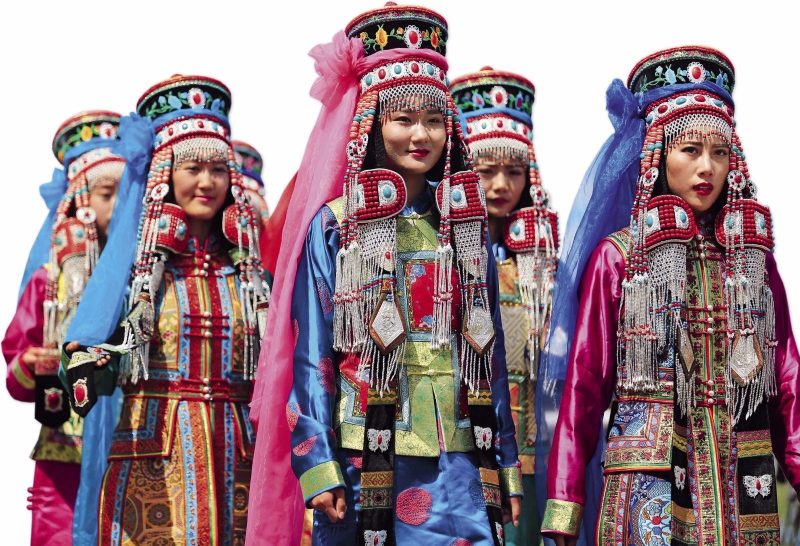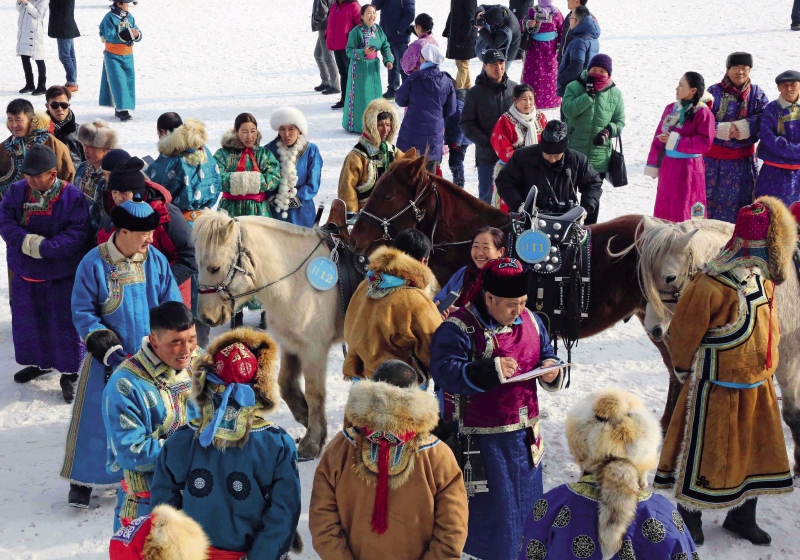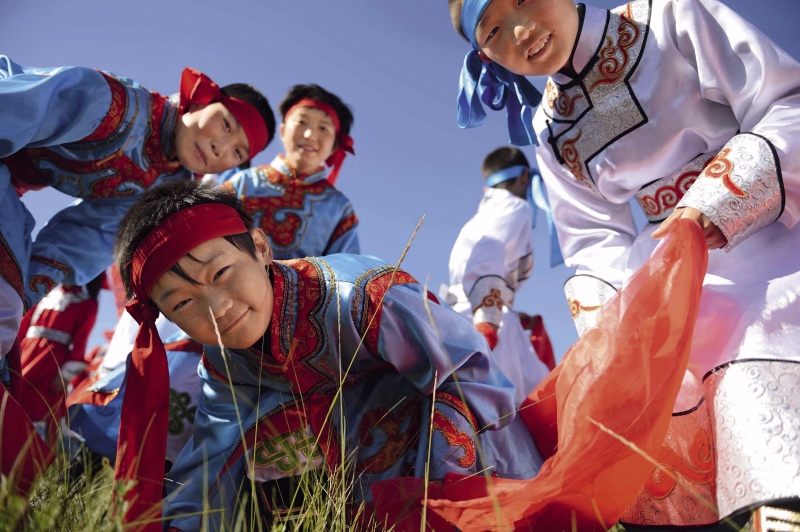
Local women wearing Mongolian costumes at the Nadam Fair.
Mongolian characteristics can be best reflected by their traditional clothing. According to archaeological data, Mongolian clothing originates from the ancient Chinese northern nomadic clothing. Over time the clothing evolved to include items such as boots, belts, hats, and jewelry as adornments. This kind of clothing has a lot to do with the nomadic lifestyle of the northern steppe where the temperature is low and conditions are often inhospitable. It must therefore be able to withstand the harsh weather and be comfortable enough to ride a horse; subsequently items such as robes, waistcoats, leather hats, and leather boots are essential.
Although the various Mongolian tribes have formed their own distinctive and colorful clothing styles due to the differences in natural environment, economic status, and living habits, generally speaking, the styles of Mongolian robes, both men and women, are basically the same. Bright colors are preferred, which makes people feel happy. The robes are all fastened at the front on the right with lots of buttons. The hems are embroidered with golden and silver silk. Men’s clothes, usually blue and brown, mostly have wide collars and big sleeves, while women’s clothes are more colorful, often in bright red, pink, green, and sky blue. According to Mongolian tradition, married women and unmarried women wear different clothing, with married women often dressed in different styles of waistcoat.
In addition to robes, boots are also a feature of Mongolian outfits. Mongolian boots are suitable for horse riding. They protect the legs of the rider, and make it easy for him or her to place their feet in the stirrups. Walking on the grassland, the boots can provide protection from the wind and sand; and in winter, keep out the cold. Therefore, local people, regardless of age, all like to wear boots.

Mongolian clothing in winter.
Mongolian boots are basically divided into three kinds: leather boots, cloth boots, and felt boots. Traditional Mongolian boots are home-made; few people buy them at the market. The leather boots are normally made of cowhide, horsehide, or sheepskin and are durable, waterproof, and warm, featuring exquisite designs. They have a variety of styles with rolled-up toecaps, half rolled-up toecaps, flat bottoms, pointed toecaps, or round toecaps. With special techniques, patterns are stitched or pasted onto the outside of the boots. The cloth boots are mostly ankle boots, which are light and soft to wear. These boots are embroidered with auspicious patterns, which are deeply loved by Mongolian women. Felt boots are made of wool or camel hair and are normally worn in bitter winter.
Belts, hats, and jewelry are also important components of traditional Mongolian costumes. The Mongolian belts have a unique function in their nomadic life. From a practical point of view, when riding a horse, a tightly-tied belt can help reduce injury from the pounding the body receives, while when working, it can protect the waist, and give support to the body during hard physical labor.
Men’s belts are usually hung with local fire makers, Mongolian knifes, cigarette pouches, white-cloth handkerchiefs, and other accessories. The belts are made of silk or cotton cloth, three or four meters in length, which reflects the aesthetic taste of the Mongolian people. For example, when a man is wearing a belt, he should keep the upper part of the robe loose to make him look stronger. Unmarried women look slimmer with the right belt. Married women do not wear belts in most cases.

Mongolian children play on the grassland in summer.
Wearing jewelry and hats is also a traditional custom of the Mongols. The first Mongolian hats were made of mink, fox skin, and sheepskin. Later cotton, linen, silk, and other fabrics appeared, enriching the forms of hats. Different Mongolians have their own preferred hats, with styles such as eagle hats, bowler hats, peaked-eaves hats, snow hats, and headscarves.
Mongolian jewelry is mostly seen in the woman’s headdress. Women of different ages and regions have different headwear. Generally speaking, girls’ jewelry is simpler but more elegant than that of married women; they wear only earrings and bracelets. Married woman do, however, like wearing a headdress in red coral, agate, turquoise, pearl, jade and other semi-precious stones and raw materials to decorate themselves.
To Mongolians, dress is an important matter. In their eyes, neat and correct dressing shows self respect and respect for others. They wear boots and hats when wearing robes, especially at a sacrificial ceremony, to match the solemnity of the occasion. When serving tea or making a toast, they do not roll up their sleeves, nor expose their chest or neck, nor sweep the hem of their robes over the pots. Nowadays, there are less occasions for Mongolian people to wear their traditional attire. Even in the pastoral areas, people wear traditional clothes and modern clothes alternately. Only during festivals, weddings, or at the Nadam Fair do people wear colorful traditional clothes.
The colorful Mongolian traditional costumes reflect the wisdom and aesthetic taste of the people, and symbolize their frankness and open-mindedness, which has become a typical symbol of the Mongolian culture.
___________
GUO ZHIDONG is a researcher of traditional culture at the No. 93 Courtyard Museum.